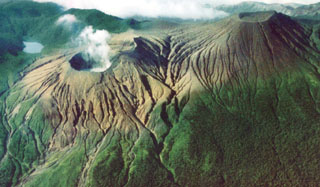Report on Rincon de la Vieja (Costa Rica) — 12 April-18 April 2023
Smithsonian Institution / US Geological Survey
Weekly Volcanic Activity Report, 12 April-18 April 2023
Managing Editor: Sally Sennert.
Please cite this report as:
Global Volcanism Program, 2023. Report on Rincon de la Vieja (Costa Rica) (Sennert, S, ed.). Weekly Volcanic Activity Report, 12 April-18 April 2023. Smithsonian Institution and US Geological Survey.
Rincon de la Vieja
Costa Rica
10.83°N, 85.324°W; summit elev. 1916 m
All times are local (unless otherwise noted)
OVSICORI-UNA reported that small phreatic eruptions, often in association with observed emissions, occurred at Rincón de la Vieja during 11-17 April. A small phreatic eruption on 11 April consisted of several pulses of activity recorded during 0653-0700 and at 0743. Gas-and-steam plumes rose 500 m above the crater rim. A small phreatic event was recorded late in the evening. An event at 0450 on 12 April produced a gas-and-steam plume that rose 500 m and another was recorded at 1920 with no visual observations reported. Gas-and-steam emissions from a phreatic event were seen at 0632 on 13 April; an event was recorded at 1826 with no visual observations reported. At 0936 on 14 April an event produced a gas-and-steam plume that rose as high as 2 km and was seen from Curubandé. The event was preceded by a swarm of long-period earthquakes five hours prior to the eruption; sediments were possibly ejected from the crater lake and deposited on the crater floor. A small phreatic eruption at 0647 on 16 April ejected material out of the crater and produced a gas-and-steam plume that rose 2 km. A smaller emission rose 500 m at 0957 and at 2235 an event generated a plume that rose 500 m. At 1237 on 17 April a phreatic event produced a plume that rose 1.5 km above the crater rim and a brief event was recorded at 0722 on 18 April.
Geological Summary. Rincón de la Vieja, the largest volcano in NW Costa Rica, is a remote volcanic complex in the Guanacaste Range. The volcano consists of an elongated, arcuate NW-SE-trending ridge constructed within the 15-km-wide early Pleistocene Guachipelín caldera, whose rim is exposed on the south side. Sometimes known as the "Colossus of Guanacaste," it has an estimated volume of 130 km3 and contains at least nine major eruptive centers. Activity has migrated to the SE, where the youngest-looking craters are located. The twin cone of Santa María volcano, the highest peak of the complex, is located at the eastern end of a smaller, 5-km-wide caldera and has a 500-m-wide crater. A Plinian eruption producing the 0.25 km3 Río Blanca tephra about 3,500 years ago was the last major magmatic eruption. All subsequent eruptions, including numerous historical eruptions possibly dating back to the 16th century, have been from the prominent active crater containing a 500-m-wide acid lake located ENE of Von Seebach crater.
Source: Observatorio Vulcanologico y Sismologico de Costa Rica-Universidad Nacional (OVSICORI-UNA)

